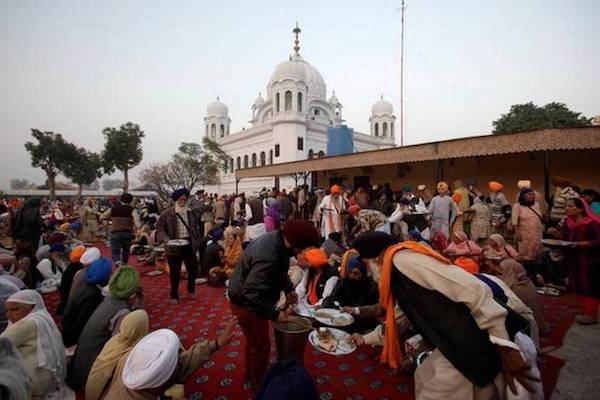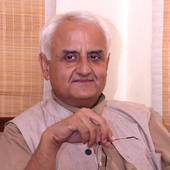

“Nothing has worked, and we are today in suspended animation between Mr. Modi’s India-centric vision of the region and the Pakistani military’s control of the geopolitical discourse in Islamabad. At such a time comes the possibility held out by the Kartarpur Corridor.”
For a flickering moment in the last week of November, it seemed as if Congress provocateur and Punjab Minister Navjot Singh Sidhu might set the geopolitical agenda, when he unabashedly spoke of the need for India and Pakistan to mend fences. He was in Lahore on the occasion of the start of work on the Kartarpur Corridor, meant to ease the travel of Sikh pilgrims to the resting place of Guru Nanak.
Unfazed by ridicule on Indian television, the cricketer-turned-politician spoke of peace, trade and people-to-people contact, all of them lost causes of the ‘track two’ dialogues of past decades. His confidence seemed to emanate from being a Sikh and Punjabi reaching out to Pakistani Punjab, and in his wordy sermons one actually detected the formula for India-Pakistan cohabitation, which would also catalyze cooperation in the larger South Asian region.
Ultra-nationalist fog
Peace in the Subcontinent presupposes amity between India and Pakistan, and more than 40 years of efforts at regionalism has been held hostage by hostility of the two, with the other countries watching askance.
The abuse hurled by the state establishments of each side is a populist political tool that distracts the public from pressing matters of growth, equity, democracy and accountability. That the cost of maintaining massive militaries in each country drags down efforts at social justice is lost in the fog of ultra-nationalism.
India, as the more stable democracy, should inculcate empathy for the neighbor, but the New Delhi commentariat tends not to recognize the difference between the Pakistani state and its people, the latter struggling against extremism, military supremacy and state-centralism all at one go.
Indian media by and large is not bothered by the travails of Pakistanis, as right-wing trolls rule the airwaves and social media. Similar to how dissent is sought to be silenced with the ‘Urban Naxal’ tag, since long those seeking India-Pakistan amity and South Asian regionalism are rejected as romantic peaceniks lighting meaningless candles at Wagah-Atari.
The trolling and abuse on all matters related to Pakistan can be expected to peak as India’s general election of 2019 draws near, which will only help Islamabad’s military-intelligence complex tighten its grip on the society. It is high time to try once again for a plan for South Asian regionalism.
Opportunity costs
The potential of South Asia for sustained high growth has been blocked by the tightened national borders, with India playing its part by building barbed wire fences on the Pakistan and Bangladesh frontiers. In all of seven decades, the economic history of the Subcontinent has been forgotten, with the ultra-nationalist narrative having us believe that this separate living is how it has always been.
Until Cyril Radcliffe drew the map of Partition, the economic synergy across the different parts of the Subcontinent was an unquestioned historical reality. There is no one to remember or remind that this reality of sealed borders was set only in 1947 for most parts of the Subcontinent, or that the door actually slammed shut only after the India-Pakistan war of 1965.
As the historical ‘connectivity’ of the Subcontinent crumbled, it created massive dysfunction as economies of scale and production chains were disrupted. The opportunity costs have been incalculable in terms of infrastructure, production and commerce, and the loss in livelihoods would be heart-rending if only we cared to calculate.
The present-day failure of South Asian academia is its unwillingness to theorize on the promise of economic growth and social justice that regionalism holds, through soft/open borders. Of the Indian intelligentsia, the failure is also in seeing economic geography through the New Delhi lens rather than those of the ‘peripheral’ regions, from Rajasthan to the Northeast.
‘South Asia’ must be understood as a project for social justice, to be achieved through economic rationalization, sub-regional interactions and reduced military budgets – and open borders such as exists between Nepal and India.
Counter-populism
The goal of the future should be to learn to compartmentalize one’s perceptions of the ‘other’, that Pakistan is made up of its state and its people just as India too is made up of its state and its people. The mutual demonization has to do with conflating the two, state apparatus and citizenry, as one.
While the Pakistani state is rightfully critiqued for the way the military/intelligence calls the shots — from the Kargil misadventure to cross-border militancy, to even denying Punjab province the right to import energy from India — the self-perception of India as ‘good’ and Pakistan as ‘bad’ should have been abandoned long ago.
In Pakistan, the space of the public intellectual is circumscribed by the jihadists, the army and the military intelligence. In India, a much freer country no doubt, there is the rise of pernicious ultra-populism that keeps public figures from speaking up.
In the age of Narendra Modi, proposing South Asian solidarity is frowned upon to such an extent that academics and opinion makers, not to mention bureaucracy and even international funding agencies, all think it is better to keep aloof of the concept. Since 2016, the Prime Minister has been consistent in his refusal to attend the 19th SAARC Summit slated for Islamabad, which has rendered the regional organization comatose. His vision of South Asian regionalism is where the neighbors dance to India’s tune.
The fear that South Asia as a concept heralds some kind of supra-sovereignty is misplaced, for there is no plan afoot for supplanting of the nation-state and associated group privileges. No, the capitals are not being asked to relinquish their powers to a Subcontinental center.
Instead, a realistic formula for South Asian regionalism lies in allowing the federal units of the two largest countries — the provinces of Pakistan and the states of India — autonomy, which today exists only on paper. This is where the Punjab-Punjab formula comes in.
Even as television sought to lampoon Mr. Sidhu, we saw what was required to push for peace in South Asia — chutzpah. The Yiddish word implies the gall or audacity of a showman, and the gift of repartee to challenge the harshest of televangelist anchors.
It does seem that ultranationalist populism can only be cut by counter-populist hyperbole. Responding to the Pakistan Foreign Minister’s invitation to the Kartarpur Corridor ground-breaking, the Punjab Minister replied in a letter: “As our nations take this first step, the Kartarpur Spirit can make pilgrims of us all, venturing out on a journey that breaks the barriers of history and opens the borders of hearts and the mind, a journey that our people can walk together towards a future of shared peace and prosperity for India and Pakistan.”
If you read the words and not the perception some have of the gentleman, the future of Punjab-Punjab, India-Pakistan and South Asia as a whole can be found in the paragraph.
Punjabiyat
Nothing has been left untried in the effort to ease India-Pakistan tensions — Atal Behari Vajpayee visiting Minar-e-Pakistan in Lahore; Mr. Modi flying in for Nawaz Sharif’s birthday; secret emissaries rushing hither and yon; and ‘track two’ and ‘track three’ events of every kind.
Nothing has worked, and we are today in suspended animation between Mr. Modi’s India-centric vision of the region and the Pakistani military’s control of the geopolitical discourse in Islamabad. At such a time comes the possibility held out by the Kartarpur Corridor.
Punjab province is by far the most powerful sub-national unit of Pakistan. The Indian Punjab may not be as powerful within India in relative terms, but it is no pushover either. The two Punjabs have one history, as the stepping stone for invaders, battlegrounds that go back millennia, the shared tragedy of Partition, and the shared culture and language of Punjabiyat.
Given that South Asian regionalism can only come from a turn towards genuine federalism in India and Pakistan, Punjab Province and Punjab State are the places to start anew. It may just be Punjabiyat is the concept which will help bring India and Pakistan closer to peace, and make South Asia a safer and more prosperous place.
(Source: Tribune.. The author, a writer and journalist based in Kathmandu, is the founding editor of the magazine, ‘Himal Southasian’)





Be the first to comment